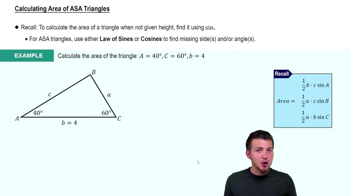Table of contents
- 0. Review of College Algebra4h 43m
- 1. Measuring Angles39m
- 2. Trigonometric Functions on Right Triangles2h 5m
- 3. Unit Circle1h 19m
- 4. Graphing Trigonometric Functions1h 19m
- 5. Inverse Trigonometric Functions and Basic Trigonometric Equations1h 41m
- 6. Trigonometric Identities and More Equations2h 34m
- 7. Non-Right Triangles1h 38m
- 8. Vectors2h 25m
- 9. Polar Equations2h 5m
- 10. Parametric Equations1h 6m
- 11. Graphing Complex Numbers1h 7m
1. Measuring Angles
Radians
Problem 59
Textbook Question
Work each problem. See Example 5. Irrigation Area A center-pivot irrigation system provides water to a sector-shaped field as shown in the figure. Find the area of the field if θ = 40.0° and r = 152 yd.
 Verified step by step guidance
Verified step by step guidance1
Convert the angle \( \theta \) from degrees to radians using the formula: \( \text{radians} = \text{degrees} \times \frac{\pi}{180} \).
Use the formula for the area of a sector: \( A = \frac{1}{2} r^2 \theta \), where \( r \) is the radius and \( \theta \) is the angle in radians.
Substitute the given values into the formula: \( r = 152 \) yards and \( \theta \) in radians.
Calculate the expression \( \frac{1}{2} r^2 \theta \) to find the area of the sector.
Ensure the units are consistent and the final area is expressed in square yards.
 Verified video answer for a similar problem:
Verified video answer for a similar problem:This video solution was recommended by our tutors as helpful for the problem above
Video duration:
3mPlay a video:
Was this helpful?
Key Concepts
Here are the essential concepts you must grasp in order to answer the question correctly.
Sector Area Formula
The area of a sector in a circle can be calculated using the formula A = (θ/360) * π * r², where θ is the angle in degrees and r is the radius. This formula derives from the proportion of the circle that the sector represents, allowing us to find the area based on the angle and radius.
Recommended video:

Calculating Area of ASA Triangles
Radians vs. Degrees
Understanding the difference between radians and degrees is crucial in trigonometry. While degrees are a more common unit for measuring angles, radians are often used in mathematical calculations. To convert degrees to radians, multiply by π/180. This conversion is essential when applying trigonometric functions or formulas that require angles in radians.
Recommended video:

Converting between Degrees & Radians
Trigonometric Functions
Trigonometric functions such as sine, cosine, and tangent relate the angles of a triangle to the lengths of its sides. In the context of a sector, these functions can help in understanding the relationships between the radius, angle, and area. Familiarity with these functions is important for solving problems involving circular shapes and angles.
Recommended video:

Introduction to Trigonometric Functions

 5:4m
5:4mWatch next
Master Converting between Degrees & Radians with a bite sized video explanation from Patrick Ford
Start learningRelated Videos
Related Practice










